External Directors’ Roundtable Discussion
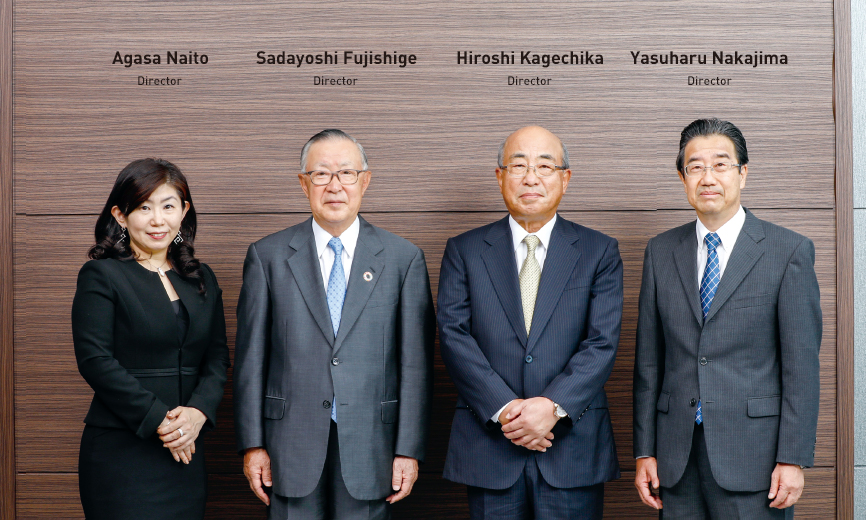
The Nittobo Group’s unique innovation lies in the power of our human resources, who have created discontinuous innovation from continuous management resources.
Please discuss your evaluation of our corporate governance and topics and areas in which you want to utilize your own personal experience and skills.
-
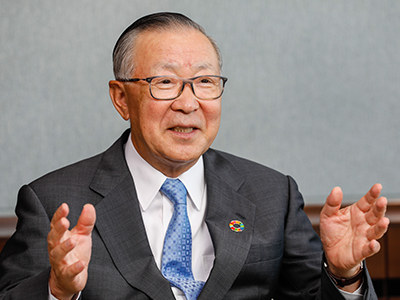 FujishigeNittobo’s Board of Directors is composed of three internal directors and four external directors. This makes it fair and impartial, allowing the Board to fulfill the function of supervising the Company from the shareholders’ perspective. The Board also leverages the respective areas of expertise that each external director brings to the table.
FujishigeNittobo’s Board of Directors is composed of three internal directors and four external directors. This makes it fair and impartial, allowing the Board to fulfill the function of supervising the Company from the shareholders’ perspective. The Board also leverages the respective areas of expertise that each external director brings to the table.
Prior to Board of Directors meetings, an advance briefing with a very lively discussion based on the meeting’s agenda is held to enhance the actual functioning of the Board of Directors.
From a management perspective, I hope primarily to play a role in overseeing the priorities and direction of the Company’s medium- to long-term management strategies. I have experience managing a general consumer goods company, so I think I have more information from the perspective of understanding customer needs and the direction in which trends in the world are heading.
As chair of the Nomination Committee, I am also involved in the Company’s succession planning, and I think that we are making steady progress here. -
KagechikaThe Board of Directors’ advance briefing is very rich in content, and the executive side provides very sincere and detailed explanations. I believe this creates a very conducive environment for discussion at Board of Directors meetings.
Of the external directors, I am the only member with a technical background. Since I have experience in the R&D department, especially in the materials industry, I am able to offer my opinions as appropriate on the state of R&D for companies, like Nittobo, that make materials. I took office in 2020 when the current Mid-Term Business Plan was being considered and had some input. Specifically, I commented on the research and development system and organizational structure of the Research & Development Headquarters. In April 2020 a new research site, NI-CoLabo, was completed at the Research & Development Headquarters. I proposed that the corporate laboratory function be properly positioned within the Research & Development Headquarters and that a research unit for the Glass Fiber Business and a research unit for the medical business be created and staffed as division laboratories under the Research & Development Headquarters.
I have engaged in discussions so as to reflect the thinking of President Tsuji in the Mid-Term Business Plan. -
NaitoAs Mr. Fujishige mentioned, I think our Board of Directors has a well-balanced composition in terms of governance. Of the seven directors, four are independent external directors, including experts in management, research and development, accounting, and law, so there are gatekeepers on both the offensive and defensive sides of corporate management. Even with a diverse composition, though, it still must function properly in practice. I feel that opinions are freely and openly expressed at Board meetings, and I think that the advance briefings that you both mentioned are not just a place to explain agenda items but also play a very important role as a forum for informal exchange of opinions, such as bringing awareness to issues or concerns.
-
NakajimaI have experience as a CPA, and now that I have been appointed as chair of the Audit Committee, I’m looking forward to managing it well.
First, we will listen carefully to the way the Audit Office conducts the audit, and then we will proceed with the audit while making various judgments ourselves. Specifically, we will focus on whether the organization has good risk management. And since on-site audits are also conducted remotely, especially overseas, owing to the COVID-19 pandemic, we will focus our supervision on internal controls in place.
How would you evaluate progress in the first year of the Mid-Term Business Plan?
-
FujishigeIn terms of progress of the Mid-Term Business Plan, we have met our targets for the first year and are doing well in a market environment that has fluctuated greatly due to the COVID-19 pandemic. Now we are aiming to improve on the following two points: First, we have a very strong ability to develop advanced technologies, but this is an ever-evolving world. New technologies are being developed one after another. We need to have a much stronger sense of touch with the cutting edge, and, moreover, we need to be proactive in collaborating with other research institutions.
Second, we aim to become highly market-sensitive. Traditionally suppliers have been the main source of market information, but from now on we must collect a wider range of information with greater sensitivity. I intend to actively support these two goals. -
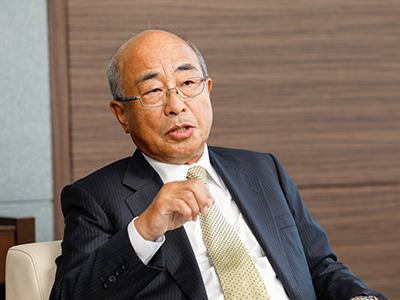 KagechikaIn a manufacturing company such as ours, manufacturing technology remains fundamental. We must further strengthen the development of process-related technologies. In fiscal 2022, the second year of the Mid-Term Business Plan, we are working to strengthen the process development system at the Research & Development Headquarters by consolidating some of the development functions at the factories into the R&D center, and we expect to see positive results in the future. For example, the Research & Development Headquarters can now take the lead in addressing such pressing issues as improving yields and increasing customer satisfaction with the quality of next-generation products.
KagechikaIn a manufacturing company such as ours, manufacturing technology remains fundamental. We must further strengthen the development of process-related technologies. In fiscal 2022, the second year of the Mid-Term Business Plan, we are working to strengthen the process development system at the Research & Development Headquarters by consolidating some of the development functions at the factories into the R&D center, and we expect to see positive results in the future. For example, the Research & Development Headquarters can now take the lead in addressing such pressing issues as improving yields and increasing customer satisfaction with the quality of next-generation products.
I recently discussed with the President of the Research & Development Headquarters how it has started to experiment with original ideas and thoughts, apart from themes already being worked on, under the “20% rule,” in which 20% of each staff member’s capacity is being allocated for this purpose. We are especially trying to provide young people with opportunities for trial and error and an environment in which they can demonstrate new technological ideas without fear of error. I hope that this 20% rule will be a catalyst here. -
NaitoOf the four pillars of the Mid-Term Business Plan, I am especially interested in human resource development. I have a feeling that in the future organizations that have not made progress in diversity and inclusion will not be able to recruit talented people. The ratio of females in managerial positions at the end of fiscal 2021 was 4.9%, less than 5% and still short of the goal of 10% by 2030. Of course, our objective is not only to increase the ratio of female managers but also to create an organization in which diverse human resources can play an active role in their own right, which we believe will lead to innovation and in turn attract more talented people. By doing so, employee engagement will naturally increase. This won’t move forward overnight, but we intend to follow it carefully.
-
NakajimaSince the Mid-Term Business Plan was formulated, very significant changes have taken place. One is the COVID-19 pandemic, and another is the trend towards decarbonization. Both the principles of corporate behavior and the direction of development must shift in response to these changes. This is a costly issue, and further structural reform may be necessary depending on changes in the world. We will look at how to respond to changes from a financial and accounting standpoint.
How should we foster human resources for innovation?
-
FujishigeThis is very simple: Encourage young people to make the most of their abilities. We will consider financial allowances, treatment, and opportunities to do the kind of inspired things they want to do. Or, as Ms. Naito mentioned, it is essential to nurture the seeds of new innovation through serendipity, in other words, chance encounters, by combining diverse human resources. Since there is no right answer to innovation, I think it is important to have the courage to try anyway and take up the good things in the process. And we must firmly support those who are predisposed to change. Such a management mindset is necessary.
-
KagechikaI believe we must be sure to create an environment that nurtures our human resources. The key here is good pride, that is, confidence in one's skills and sense of mission. There are expectations for each position, and the Company should provide an environment where this is properly recognized.
When new graduates join the Company as researchers, to develop them into full-fledged professionals in a certain technical field as quickly as possible, they need to recognize how much they have improved as technicians through discussions with customers, activities at external academic conferences, interactions with external researchers, and presentations of their own achievements. We should make sure to create such opportunities and develop individual communication skills each time.
Furthermore, as the mission of the organization, the executives must focus their wisdom, accurately set themes, and draw out the abilities of the hard-working researchers. If each young researcher can develop his or her career and grow in the process of working on a theme, the output of the Research & Development Headquarters will increase, and it will become more active. -
NaitoI agree with both of you about how to develop human resources. However, the significance of the human resources that we so painstakenly do nurture will be reduced by half if they do not function effectively. I believe that for the human resources developed in each department to be able to work effectively in our organization, good communication between departments is extremely important.
I understand and am very excited about the fact that this point was also recognized in the discussion of the Mid-Term Business Plan and led to the introduction of the Customer Success Task Force, a mechanism to share customer needs and product ideas more efficiently and to link marketing, product planning, and product development to strengthen customer solution capabilities.
In this volatile business environment, the key to success is how many customers we can attract who love Nittobo products. To draw out the full potential of our human resources, it is essential that we work together organically, flexibly responding to each situation as necessary with the appropriate team, without putting up barriers.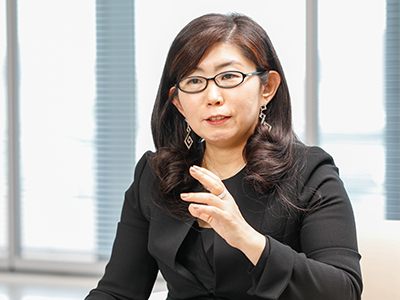
-
NakajimaWhen someone who has the courage to bring about change joins an organization, I believe it is up to the organization to make the most of that person. My point is that I wonder if there is a way to incorporate change-oriented human resources into the organization as a strength of the team.
As you all said, by improving openness and communication, we can form a team or organization to make the most of plucky human resources, which in turn will attract more bold-spirited human resources to us. If we can get the ball rolling, it will work positively in various ways. If it starts to roll the other way, though, good people are going to quit. So the first step is to get the ball rolling in the right direction.
What kind of efforts should be made in the future to realize Big VISION 2030?
-
FujishigeBecoming a Global Niche No. 1 company is a very important theme, and it means always having a perspective on how to be no. 1 in the world. To this end, we will send people with a mindset of change and young people to train in the world market. I think it is very important to screen people who will survive and thrive in a tough environment, because people cannot grow in an easy environment. Again, it is important to switch to a highly market-sensitive structure.
-
KagechikaThe goals of Big VISION 2030, including decarbonization, are high and will not be easily met just by extending current technologies. Basically, problem solving will be driven by technology. But since our technological development capability must also achieve one or two higher levels of innovation, it will be necessary to review themes from the beginning.
We possess advanced technologies and human resources that have been accumulated in Group companies over our long history, so now is the time to strengthen the system in which the entire Group works together for development. This will come up in discussions for the next mid-term business plan, but I would like to focus on how to consolidate and increase the power of the technical human resources dispersed throughout the Group, including governance. -
NaitoNiches are constantly changing and becoming more sophisticated in response to the times. In other words, the key point is how to develop professional human resources and global human resources who can stay abreast of the most advanced niches in the world.
Sustainability management is another globally important key term. We have established the Sustainability Committee to focus on environmental issues, but sustainability management issues and environmental challenges tend to become an end in themselves if we make them a specific goal. The question is how to incorporate them in conjunction with medium- and long-term corporate value and how to appeal to multiple stakeholders.
I believe that we must backcast from where we want the Company to be and constantly look back to where we are today. While regularly reviewing our goals, we must endeavor to substantially enhance our corporate value and showcase our efforts to the world. -
Nakajima“Global niche No. 1” is a phrase that fits the Company perfectly. I can see that we really are an enterprise that competes in niche markets in the form of top quality. I believe that growth is a steady accumulation of efforts, so I agree with this global niche idea. But the key point is to find ways to realize Big VISION 2030 in our ongoing daily activities.
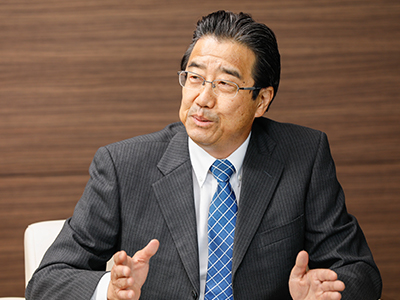
-
FujishigeIn our case, our core management resources, such as glass fiber and in vitro diagnostic reagents, are continuous, but our target markets are discontinuous. In business diversification, core management resources are continuous, but the markets and products can be varied, which is efficient diversification.
-
KagechikaThat’s exactly right. Historically, we created glass fiber by applying basic fiber technology, and we have grown substantially by discovering new materials for medical testing and linking them to business. Core technologies are indeed connected, but case by case they are discontinuous. In other words, going forward, while nurturing our core technologies, our growth will depend on spotting new businesses and opportunities.
My impression is that the goals of Big VISION 2030 look like sales and profit levels that are expected to be reached when the current business base has grown much larger. The market environment has changed dramatically, and the hurdles are certainly getting higher, so I think it would be best if we added a scenario in which new businesses are created and grown to Big VISION 2030. -
NaitoThere is a continuum in what the Company is working on and in its technology. But when it has found new markets, the Company has always transformed itself. There is no easy answer to how to find new areas for future major expansion. I believe it is partly luck.
But we can’t find them if we don't move. I hope that we can branch out into surprising territory by making efforts in both directions, such as communicating what kinds of technology we have and making inquiries to customers.
